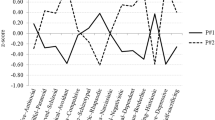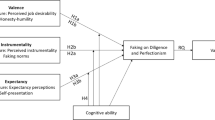Abstract
This chapter examines the prospects of the contemporary reprise of person perception accuracy. I identify three components of a paradigm for studying accuracy: a model of social judgment, a model of personality dispositions, and a methodology for examining the relation between social knowledge and behavior. I examine the implications of bounded models of social judgment, then summarize evidence of domain-specific accuracy that supports these models. The role of a conditional model of dispositions in accuracy research is discussed, and criteria for evaluating accuracy are derived from this model. I then describe a “simulated personality” paradigm which combines the strengths of laboratory experiments and observational field studies to permit detailed investigations of the relation between social knowledge and social behavior. Finally, I illustrate how this paradigm has been used to clarify the conditions under which expert clinical judges are more accurate than novices, how the veridical and non-veridical patterning of behaviors across situations influences judgment accuracy, and how observers’ interaction goals influence the accuracy of the impressions they form.
Access this chapter
Tax calculation will be finalised at checkout
Purchases are for personal use only
Preview
Unable to display preview. Download preview PDF.
Similar content being viewed by others
References
Bem, D.J., and Allen, A. (1974). On predicting some of the people some of the time: The search for cross-situational consistencies in behavior. Psychological Review, 81, 506–520.
Buss, D.M., and Craik, K.H. (1983). The act frequency approach to personality. Psychological Review, 90, 105–126.
Chase, W.G., and Simon, H.A. (1973). Perception in chess. Cognitive Psychology, 4, 55–81.
Chi, M.T.H., Feltovich, P.J., and Glaser, R. (1981). Categorization and representation of physics problems by experts and novices. Cognitive Science, 5, 121–152.
Cronbach, L.J. (1955). Processes affecting scores on “understanding of others” and “assumed similarity.” Psychological Bulletin, 52, 177–193.
Crow, W.J. (1957). The effect of training upon accuracy and variability in interpersonal perception. Journal of Abnormal and Social Psychology, 55, 355–359.
Dawson, V.L., and Wright, J.C. (1988). Forming impressions of simulated people: Goal-driven impressions and the circumscribed accuracy of dispositional judgments. Research in progress.
Dawson, V.L., Zeitz, C., and Wright, J.C. (1989). Expert-novice differences in person perception: Evidence of experts’ sensitivities to the organization of social behavior. Social Cognition, 7, 1–30.
Faust, D., Hart, K., and Guilamette, T.J. (1988). Pediatric malingering: The capacity of children to fake believable deficits in neuropsychological testing. Journal of Consulting and Clinical Psychology, 56, 578–582.
Faust, D., and Ziskin, J. (1988). The expert witness in psychology and psychiatry. Science, 31–35.
Funder, D.C. (1987). Errors and mistakes: Evaluating the accuracy of social judgment. Psychological Bulletin, 101, 75–90.
Goldberg, L.R. (1959). The effectiveness of clinicians’ judgments: the diagnosis of organic brain damage from the Bender-Gestalt test. Journal of Consulting Psychology, 23, 25–33.
Hartshorne, H., and May, M.A. (1928). Studies in the nature of character: Vol. 1. Studies in deceit. New York: Macmillan.
Higgins, E.T., and Bargh, R. (1987). Social cognition and social perception. Annual Review of Psychology, 38, 369–425.
Horowitz, M.J. (1962). A study of clinicians’ judgments from projective test protocols. Journal of Consulting Psychology, 26, 251–256.
Kelley, H.H. (1971). Attribution in social interaction. Morristown, N.J.: General Learning Press.
Kenny, D.A., and Albright, L. (1987). Accuracy in interpersonal perception: A social relations analysis. Psychological Bulletin, 102, 390–402.
McArthur, L.Z., and Baron, R.M. (1983). Toward an ecological theory of social perception. Psychological Review, 90, 215–238.
Mischel, W. (1965). Predicting the success of Peace Corps Volunteers in Nigeria. Journal of Personality and Social Psychology, 1, 510–517.
Mischel, W. (1968). Personality and assessment. New York: Wiley.
Mischel, W., and Peake, P. (1982). Beyond deja vu in the search for cross-situational consistency. Psychological Review, 89, 730–755.
Mischel, W. (1973). Toward a cognitive social learning reconceptualization of personality. Psychological Review, 80, 252–283.
Newcomb, T.M. (1929). The consistency of certain extrovert-introvert behavior patterns in 51 problem boys (No. 382 ). New York: Columbia University, Contributions to Education.
Nisbett, R., and Ross, L. (1980). Human inference: Strategies and shortcomings of human judgment. Englewood Cliffs, N.J.: Prentice-Hall.
Oskamp, S. (1965). Overconfidence in case-study judgments. Journal of Consulting Psychology, 29, 261–265.
Park, B. (1986). A method for studying the development of impressions of real people. Journal of Personality and Social Psychology, 51, 907–817.
Patterson, G.R. (1982). Coercive family process. Eugene, Oregon: Castalia. Raiffa, H. (1968). Decision analysis. Reading, MA: Addson-Wesley.
Rushton, J.P., Brainerd, C.J., and Pressley, M. (1984). Behavior development and construct validity: The principle of aggregation. Psychological Bulletin, 94, 18–380.
Shoda, Y., Mischel, W., and Wright, J.C. (1989). Intuitive interactionism and person perception: Effects of context-behavior relations on dispositional judgments. Journal of Personality and Social Psychology, 56, 41–530.
Simon, H.A. (1983). Reason in human affairs. Stanford, CA.: Stanford University Press.
Swann, W.B. (1984). Quest for accuracy in person perception: A matter of pragmatics. Psychological Review, 91, 457–477.
Wright, J.C., and Dawson, V.L. (1988). Person perception and the bounded rationality of social judgment. Journal of Personality and Social Psychology, 55, 780–794.
Wright, J.C., Jan, G., Dawson, V.L., and Shoda, Y. (1988). Forming impressions of simulated personalities: Sensitivities to the behavioral organization of “real” and “unreal” people. Manuscript submitted for publication.
Wright, J.C., and Mischel, W. (1988). Conditional hedges and the intuitive psychology of traits. Journal of Personality and Social Psychology, 55, 454–469.
Wright, J.C., and Mischel, W. (1987). A conditional approach to dispositional constructs: The local predictability of social behavior. Journal of Personality and Social Psychology, 53, 1159–1177.
Wright, J.C., and Murphy, G.L. (1984). The utility of theories and intuitive statistics: The robustness of theory-based judgments. Journal of Experimental Psychology: General, 113,301–322.
Wright, J.C., Shoda, Y., Mischel, W., and Phillips, K. (in press). Domain-specific accuracy of person perception. Journal of Personality and Social Psychology
Editor information
Editors and Affiliations
Rights and permissions
Copyright information
© 1989 Springer-Verlag New York Inc.
About this chapter
Cite this chapter
Wright, J.C. (1989). An Alternative Paradigm for Studying the Accuracy of Person Perception: Simulated Personalities. In: Buss, D.M., Cantor, N. (eds) Personality Psychology. Springer, New York, NY. https://doi.org/10.1007/978-1-4684-0634-4_5
Download citation
DOI: https://doi.org/10.1007/978-1-4684-0634-4_5
Publisher Name: Springer, New York, NY
Print ISBN: 978-1-4684-0636-8
Online ISBN: 978-1-4684-0634-4
eBook Packages: Springer Book Archive




